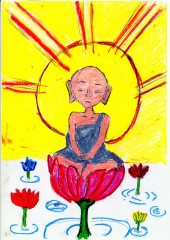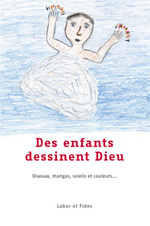Over the last few decades the study of the concept of god (also image/representation) has become one of the main research areas of the psychology of religion. This issue has been approached from different psychological perspectives, including cognitive developmental psychology, object relations theory, cognitive psychology, attribution theory and attachment theory. The concept of god is a very complex psychological construct and many scholars have noted the limitation of its current measurement, which relied mostly on verbal measures: questionnaires, interviews, list of adjectives to describe gods, etc…
The “Drawings of gods” research, headed by Prof. Pierre-Yves Brandt, is a project developed in the Faculty of Theology and Religious Studies of the University of Lausanne. The project aims to contribute to further understanding of the origin and development of the concept of god by using children’s drawings collected in different cultures and different religious traditions. Although the use of this method has been criticized, it has the potential to provide considerably more information on the way in which children conceptualize god. This more appropriate research tool offers the opportunity to undertake at the same time developmental and cross-cultural research, the lack of which has greatly limited advancements in the field.
Funding: Suisse National Science Foundation
Period: 01.04.2015 - 28.02.2019
Responsible : Prof. Pierre-Yves Brandt
Co-applicants: Zhargalma Dandarova-Robert, Dominique Vinck, Frédéric Darbellay
Contributors:
Grégory Dessart, PhD student ; Christelle Cocco, Post-Doc reseacher; Olga Serbaeva, technician.
Web-Based Database “ Drawings of gods”
The “Drawings of gods” Web-Based Database is designed to store research data and make it available not only to scholars affiliated with the research project but also to the broader public who will be interested in this issue. Currently the database contains nearly 6000 drawings collected in Japan, Iran, Romania, Russia, Netherlands, Nepal, Switzerland, USA and it is continually growing.
In the future we expect that the database will be of interest to researchers in new countries and the database will be expanded and enriched by drawings of god from other cultures. For further information or if you would like to participate in the research, please contact the project coordinator Professor Pierre-Yves Brandt Pierre-Yves.Brandt@unil.ch
Search interface, available in French and English, provides three modes to use it: open access, an authorized user (UNIL account) and authorized users, affiliated with the research project.
With open access, anyone can browse and view drawings, read descriptions made by a subject.
Authorized users (UNIL account) have larger access to the data.
Affiliated with the research project users are provided by a password and has various options for online working with data, access to the back page of drawings with the description made by a child, and to questionnaires filled by the children. They have also access to a larger version of the drawings.



